OBSERVING ASTEROIDS AND COMETS
Last updated: 3 March 2001
OBSERVING ASTEROIDS AND COMETS |
AN INTRODUCTION TO OBSERVING ASTEROIDS AND COMETS
THE FASCINATING WORLD OF INTERPLANETARY OBJECTS -
The primary objects within the sun's family - the large and bright planets - afford ETX and LX telescope users a plethora of observing opportunities, not to mention a gallery of unusual "out-of-this-world sights. Guides for telescopic observing of Jupiter (www.weasner.com/etx/buyer-user-tips/planets-jupiter.html) and Saturn (www.weasner.com/etx/buyer-user-tips/planets-saturn.html ) are found for ETX and LX users on this web site. Learning the tips and techniques, as well some pertinent information about the object itself, lends itself to a rewarding and challenging lifetime in amateur astronomy.
But in addition to these major planets there is an overwhelming wealth of other - even MORE unusual - material just within our "neighborhood": the solar system. Much of this unfortunately goes unnoticed and, for the most part - unobserved by amateur. This "stuff" comprises the ASTEROID BELT containing thousands of "minor planets," the APOLLO close-approach objects that many times pass even between the Earth and moon, and other "interplanetary objects", including the fascinating COMETS.
Fortunately for those of us with GO TO telescopes, the capability exists to locate even the faintest telescopic asteroids and comets that we might otherwise miss if it were not for the computer's capability to "take us to them." Indeed, your ETX or LX AutoStar-driven telescope is capable of accessing HUNDREDS of such objects and taking you to them, perhaps for the first time in your life!
Once the telescope has found a COMET for you, typically it is immediately recognizable...it may not be "bright" or have a "tail" and appear as ominous as the very bright naked-eye comets, but it probably will have a distinctly "fuzzy" look, like a very faint nebula.
On the other hand, even though an AutoStar can place your telescope dead center on an ASTEROID, unless you have a good set of star charts (the commercially-available CD or diskette Sky programs are adequate, to magnitude 7.5) you will never REALIZE that you are, indeed, looking at an asteroid. They merely look like faint stars; even the brightest asteroid, CERES, is a mere blip in a good pair of binoculars and looks only like a moderately bright star in a telescope!
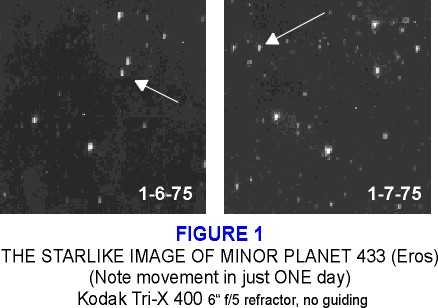
Figure 1 demonstrates the starlike appearance of #433 Eros in 1975; note also it rapid motion in just one elapsed day as it speeds across the sky at opposition.
-----------------------------
The jury is still out, and likely will be for some time to come, as to what this "material" that makes up the comets or asteroids really is. Among the interplanetary matter are small and not-so-small objects. Some of it, indeed most of it, are objects of little regular shape, the majority appearing as chunks of either stony or icy materials. All, just like the planets, orbit the sun - but for the most part each of their orbits are very distinct from anything else out there. For example, the comets seem to be large blocks of frozen gases mixed with particles of cosmic dust, while the asteroids - or "minor planets" - are hard and often metallic bodies pocked with craters. With the February, 2001 "NEAR-Shoemaker" satellite surface landing onto the asteroid EROS, it was confirmed that this little minor planet is "potato-shaped" and has a large crater one-third from one end of it.....a shape AND a characteristic (the crater) that was mapped out nearly 25 years ago by AMATEUR ASTRONOMERS using small telescopes to record ever-so-slight variations in reflected sunlight as the elongated minor planet turned on its axis!
Note that the "light curve" as plotted about every 10 to 20 minutes refers to aspects of the asteroid as drawn from over 2,000 observations with a 6" telescope. Note how remarkably close the deduced shape (even to the large crater) was 25 years before the satellite actually took the NASA images! Smaller telescopes CAN make a contribution to science!
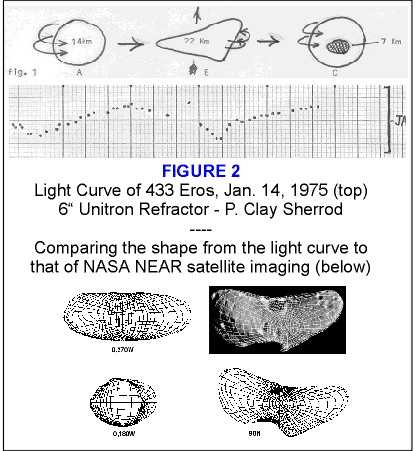
----------------------------
The Asteroids, or Minor Planets -
Just beyond the orbit of Mars, about midway to that of Jupiter is a fascinating "belt" of debris, predicted over 250 years ago in a mathematical progression known as "Bode’s Law." In this prediction, it was held that there SHOULD be a planet somewhere between Mars and Jupiter, or about 300 million miles away, three times more distant from the sun than is Earth.
In "Bode's Law" there was also room for ANOTHER "missing" planet at that time, one that the mathematical progression deemed should be just outside of the orbit of Saturn, the most distant planet know in the 17th century.
Indeed, the discovery of Uranus in 1871 by William Herschel showed that a planet did exist just where Bode’s progression said this trans-Saturnian planet should be - 1.8 billion miles from the sun!
Soon after - on the very first night of 1801 - the Sicilian astronomer Giuseppe Piazzi located a "star" that appeared telescopically to change its position against other stars. Later, it was confirmed that this object "Minor Planet 1" - the asteroid CERES (appropriately named by others, meaning "goddess of Sicily") - was orbiting exactly where the other and closer "missing" planet should have been as predicted by Bode’s law - some 300 million miles from the sun, between the orbits of Mars and Jupiter.
Within the next six years, the largest of all the minor planets had been discovered: Ceres (1801), Pallas (1802), Juno (1804) and Vesta (1807).
Incredibly, because the asteroids are so small, and thus very faint, t was not until 1845 that the fifth minor planet was discovered. In 1970 over 300 were known; today, there are over 20,000 documented!
Unfortunately for the naked eye observer, the asteroids cannot be seen. Careful planning and plotting on star charts will reveal the brightest four in a pair of 10 x 50 binoculars, but only very faintly. Even though the aforementioned four are the largest asteroids, they are still tiny when considering that we are viewing them from a distance of over 200 million miles!
Looking at the sizes, consider that mighty Jupiter, with its diameter of over 87,000 miles is seemingly small in telescopes. Thus, the minor planets - even with the largest telescopes on Earth - are but pinpoints of light and cannot be magnified to exhibit a "disk" of their irregular bodies. The sizes of the 9 largest are given in Figure 3, below as well as their BRIGHTEST ATTAINABLE magnitude, usually during "opposition," when the minor planet is opposite the sun as seen from Earth. Although some can reach naked-eye brightness, picking them out amidst the thousands of tiny stars on a moonless night is very difficult....hence, the AutoStar can show you the way!
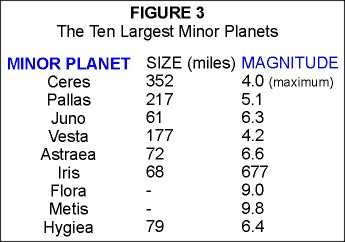
Orbiting spacecraft as well as the Hubble Telescope have been able to obtain close-pass images that reveal highly non-uniform shapes and substantial cratering from impacts, perhaps of meteors or even other asteroids in the asteroid belt.
Being outside the Earth’s orbit, like superior planets, the asteroids orbit with similar characteristics; nonetheless, the asteroid belt is very wide and the motions of the bodies within it are regulated by their masses and relative distances from the sun. Also perturbations - one object pulling on another through its forces of gravity - force many of the asteroids to vary in the orbits from time to time as the small planets are affected by the gravity of other passing bodies, particularly Jupiter.
Like all superior planets, the minor planets exhibit retrograde motion. As might be expected, the average passing across the sky (its "year") of an asteroid takes longer than does Mars', but not so long as Jupiter.
-----------------------------------
The Mysterious Comets -
There was a time, even less than 200 years ago in many cultures, that the sudden appearance and passing of a bright comet foretold impending doom or disaster. William Shakespeare wrote of comets and their appearances heralding the deaths of rulers, and other historians attributed bright comets in the sky to such dramatic events as: the fall of Constantinople, the miscarriage of pregnant cattle, and even hens laying strange eggs!
Part of the fear of comets is the UNKNOWN - their unpredictable nature. Before they were fully understood - at least as to their motions in the sky - they suddenly just seemed to "appear" like ghosts hovering in dark skies. They did not behave like the "planetes," or the "seven wandering stars" (Mercury, Venus, Moon, Mars, Jupiter, Saturn and the sun) moving predictably through the field of stars, and their motions many times could be seen within a night’s time as they rapidly approached and receded. Surely something so mysterious and unpredictable has to be the work of the Devil!
Today it’s easy to brush off the "comet scare" of times gone buy.....until you see a bright one - a really big, bright one. Even to those who have seen comets come and go, and even now that we are better able to understand when and why they appear, bright comets strike awe in the hearts of even the most seasoned stargazers.
On a dark night, with no moon in the sky, and the blanket of stars so deep that the motionless heavens seem three-dimensional, the suspension of a bright, ghostly and silent partner among those stars is a sight to behold.
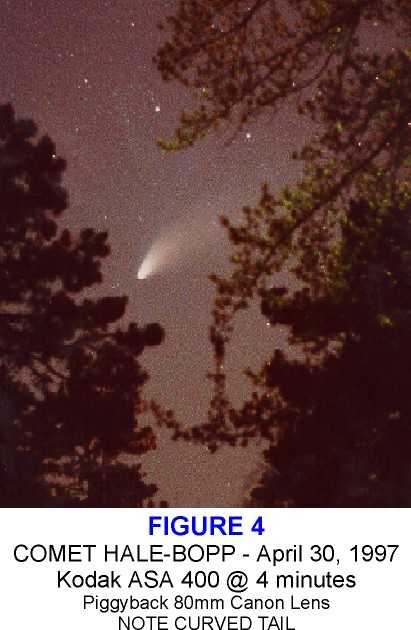
So some comets come rapidly and brush by the Earth so close that they seem to stretch across our dark skies, only to be gone in a few days. Normally those comets are sungrazers, interlopers that either have not come by the sun before, or some that approach in prehistoric antiquity. As such sungrazers are pulled into the sun, the pass remarkably close to the sun, and hence sometimes the Earth. Indeed, comets like Ikeya-Seki in 1965 skimmed through the nuclear fiery atmosphere of the sun, arcing around it in fierce speed, and exploding to such brightness that it could be seen at high noon in broad daylight!
But not all comets are bright, nor so large.... not so spectacular. On ANY given night, there are literally hundreds of comets strewn about the sky, most in sight of only the world’s largest telescopes. BUT - there are also hundreds of comets visible in YOUR telescope with the aid of the AutoStar comet directory! They are easy to GO TO and fun to observe!
Such comets that are cataloged in the AutoStar are the periodic comets, those which have been by the sun previously and are now locked into a closed orbit, highly elliptical (the flattened circle, like Mars), coming back around every set number of years. Halley’s comet, the famous comet predicted by Edmund Halley is a comet that, in earliest times, brought fear and repentance among all men. Being a periodic comet, Halley’s returns to the vicinity of the sun every 76 years or so, close enough that the sun’s energy can warm the frozen gases and vaporize enough for naked eye view of its coma (the bright "head" of a comet) and tail (a stream of bright ionized gases and dust that are pushed away from the comet’s head). In Figure 5, you can clearly see the many component "tails" of Halley's comet in 1986, these emanating from active "jets" from the comet nucleus.
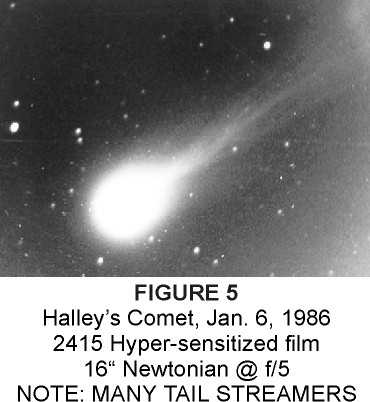
Yet, like the automobile running out of gas, it appears that Halley’s comet is literally "running out of steam." During its last pass, the sun’s energy seemed to break through the icy barrier and break apart large chunks of the estimated 10-mile wide "dirty iceball." Astronomers with large telescopes noted in April, 1986 that several nuclei (the nucleus of a comet is the bright star-like point of light that is the comet itself, usually seen central amidst the comet’s head (see Figure 6).

---------------------------
PERIODIC COMETS - First we will discuss the motions of the periodic comets. As mentioned all comets ultimately - once passing the gravitational pull of the sun and being "perturbed" into an orbit (Figure 7) - are "periodic." Some have regular and predictable orbits which bring them by on a relatively short basis.
One of the most famous periodic comets is Comet Encke with an orbital period around the sun of only 3.3 years, compared to Halley’s Comet at 76 years. Once a very spectacular and bright object, Encke’s comet, at every pass by the sun (perihelion), was gravitationally tugged into a less and less elliptical orbit and its outer limit (aphelion) gradually grew closer and closer to the sun until it was locked into nearly a circular orbit of only 3.3 years.
There are thousands of periodic comets throughout the sky and each year a few of them pass close enough to the sun and Earth that they become easily visible in small telescopes, binoculars or even the naked eye. Observing hyperbolic comets offers the most spectacular and unexpected rewards within the comet family.
----------------------------
HYPERBOLIC COMETS - The most spectacular comets, with few exceptions, are the newly discovered hyperbolic comets, objects that enter our solar system and appear to make their first treks around the sun. Recent observations of such comets reveal that - once passing the sun - they do not "escape" and disappear forever away from its gravitational forces. Hence, the name is somewhat outdated but sticks nonetheless.
Essentially, once passing perihelion, such comets become extremely lengthy periodic comets, and indeed will return at some future data. It is important to note here the obvious difference in the motions of the short period comets and these relatively new interlopers.
If you are fortunate to see one of these "hyperbolic comets" it is likely the first time it has been seen by mankind and likely will not be seen again in your lifetime. They are the ones referred to by ancient historians as causing great calamities and the miscarriages of pregnant cattle. As well, they show up very unexpected for the unprepared. Prior to the invention and use of the modern telescope, comets went totally unnoticed until they were so bright as to call immediate attention by the lay public. Many times the suddenness of their appearance would cause panic and terror, as many of these comets attain tails stretching from the horizon to nearly overhead, and many take on mysterious shapes, appendages and unusual characteristics.
As we have seen the periodic comets are not so bright, so it are the new comets to which we refer when speaking of "spectacular" comets. And there is ample reason that they should be most spectacular.
A comet approaching the sun for the first time enters from space, perhaps at a distance of 12 trillion miles, being nudged by some gravitational force by another object and "pushed" into a very slow (at first) trip into the center of the solar system.
This "fresh comet" is packed full of frozen gases and dusty particles left from the actual creation of our solar system, well over 5 billion years ago. Until reaching about the distance of the orbit of the planet Mars, or about 60 to 100 million miles from Earth, the new comet remains for the most part unchanged, slowly evaporating its outer layers as the effect of sunlight and solar wind gently warm this hitherto frozen and unexposed object.
Today, many new comets are discovered as much as a year or two prior to becoming a public spectacle. At even this early discovery, the comet may only be a few hundred million miles distant, as opposed to its starting point nearly one-third the distance to our nearest star, Alpha Centauri.
The trip from its "birthplace" to our region where we might first glimpse the comet has taken millions of years. Comets are traveling at a snail’s pace when they leave the Orrt Cloud; by the time they reach perihelion, many are speeding by in excess of 25 miles per second.
At such a fast pace it is easy to understand why the comets seem to suddenly appear, change shape and brightness radically and as quickly....disappear.
For the casual observer viewing a very bright comet is much like observing Venus or Mercury, although there are some exceptions. When the comet is close enough to become naked eye, it obviously is very close to the sun, the sun’s energy enteracting with the volatile materials of the comet, causing ionization of gases (like a glowing fluorescent light) and rapid melting of hence frozen dust and solid particles which stream away from the center of the comet away from the sun. Notice in Figure 7, how the "tail" seems to follow the comet as it approaches the sun; however, after passing its closest approach to the sun ("PERIHELION") the tail now clearly "leads" the comet, being propelled away by the force of solar wind.
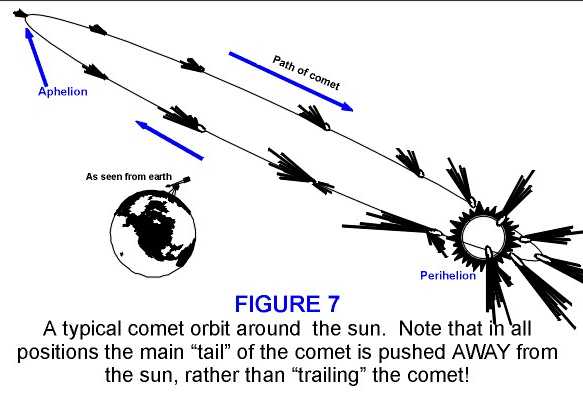
During such close approach the long and famous "tail" develops and is pushed by the solar wind away from the sun like the dust particles. Only the heaviest particles (see actually "follow" the comet in its orbital path as shown with the photograph of Halley's Comet in April of 1986 after it had passed the sun (Figure 8). In this photograph you can clearly see the dust tail (from a "clock position of 12:00 to about 2:00") making a fan-shape of the main tail (from comet to upper right).
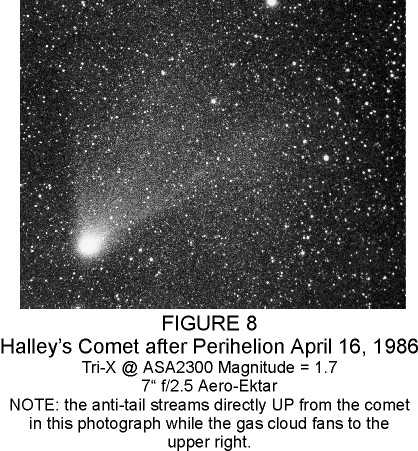
----------------------------------
OBSERVING THE COMETS WITH YOUR TELESCOPE AND THE NAKED EYE -
Because the comet is so close to the sun, it will usually be seen best either before sunrise in the eastern sky, or after sunset in the west. Since the very brightest comets are those which pass the closest to the sun (thereby more heat and energy), it stands to reason that the very close ones must be viewed very close to dusk in the evening or dawn in the morning.
As the comet moves farther away from the sun after perihelion, it will rise higher and higher in the sky when compared to the sun, but its brightness from Earth also diminishes for two reasons:
1) the comet is getting less and less energy from the sun, and therefore is not as luminescent as when receiving maximum energy;
2) as the comet recedes, its brightness decreases proportionally to its distance.
Thus, when a bright comet appears, the best words of advice are: "see it while you can and as often as you can! Indeed, the comets afford a different "show" every night, with many gas jets erupting as they pass closely to the sun; the tail grows and diminishes as the comet approaches and then recedes from the sun.
Watching a comet over its brief appearance is a rewarding experience to share. For starters:
1) note (plot if you like) the changing POSITION of the "tail" relative to the comet’s head; comparing your plots with a star chart will reveal that the tail does indeed point "away" from the sun! Remember that the tail is being PUSHED by the solar wind, not actually FOLLOWING the comet; only the heavier dust grains follow in the comet's path, and those are seen by REFLECTED SUNLIGHT (see Halley's Comet Figure 8).
2) compare the magnitude of the head of the comet with bright stars in the sky, either with your telescope if the comet is reasonably faint, or with binoculars and the naked eye; if using binoculars or a telescope, try "defocusing" the image in the optics to make the same size as the comet is seen IN FOCUS and this will give you a more accurate magnitude comparison. The HEAD, or COMA of the comet can be as large as the distance from the Earth to the moon, or greater than 250,000 miles across. The coma can be seen because of the IONIZATION and FLUORESCENCE of the rare gases in the nucleus, a result of exposure to the sun's energy.
3) look nightly for the bright NUCLEUS in your telescope; some times, as in the last pass of the famous HALLEY’S COMET, the tiny nucleus can split apart from solar radiation and become a multiple fragmented body! The nucleus of a comet is a very small object, when you consider the coma may be over a quarter-million miles across! Indeed, even the largest nuclei of comets range no greater than 15-20 miles across (Figure 6).
4) under very dark skies examine carefully for the "anti-tail", the tail which can be seen actually FOLLOWING THE COMET in its path; this antitail is actually heavier particles of dust and grit that the comet is leaving behind in its wake, unlike the bright gas and luminous cloud which is repelled by the solar wind. Usually, the best time to pick up the "anti-tail" is immediately after the comet passes PERIHELION, or closest pass to the sun, as seen in Figure 7).
---------------------------
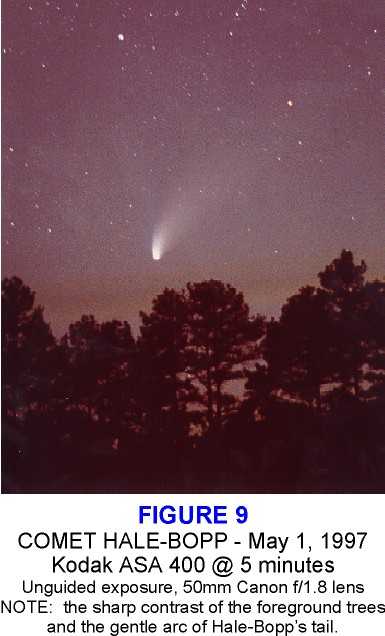
PIGGYBACK PHOTOGRAPHY OF COMETS -
The very best photographs of comets are usually taken by "piggyback photography" whereby a camera "rides" atop a tracking telescope; the camera with a standard lens can cover wide expanses of sky; with a bright comet (see Hale-Bopp, Figure ) exposures of only 5-8 minutes on fast (ASA400) film are required!
Beautiful photographs such as the one above can be obtained easily with a piggybacked camera on an ETX or LX telescope, or with very short exposures and fast film (to keep star images from trailing as the Earth turns). Use film faster than ASA 400 and expose for only about 5-10 minutes with a regular camera lens using a "cable release" to keep the camera's shutter open. With piggyback photography, lenses of all focal lengths (see Figure 8, taken with a 7" piggybacked lens) can be used for very long exposures while the telescope actually tracks for the motion of the Earth and comet and the camera/lens combination does all the work!
---------------------------
There is much literature available on the physical nature of comets and the remarkable detail that can be seen within them. Using any optical aid will enhance the views of the inner secrets of the comet.....outgassing of geyser-like spews of rare gases ("jets" that emanate from the nucleus and curve gracefully into the coma.....faint "tail components", extensions from the nucleus that combine into one large bright tail...and sometimes a nucleus that divides, or erupts in brightness unexpectedly.
All await your yearning for discovery in your telescope. Yet, the true splendor of these as-yet still mysterious ghost-like bodies can best be seen with the unaided eye on a dark night as they hover silently over the eastern horizon at dawn or the western horizon at sunset. They follow the sun like sentries that soon will fall into the shadows of the great star of our solar system.
P. Clay Sherrod, Arkansas Sky Observatory - Petit Jean Mountain Arkansas
Return to the top of this page.
Go back to the Observational Guides & References page.
Go back to my ETX Home Page.